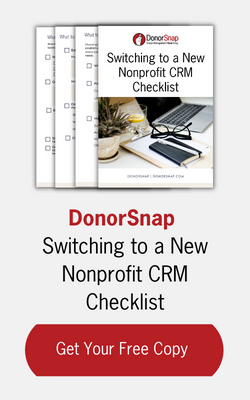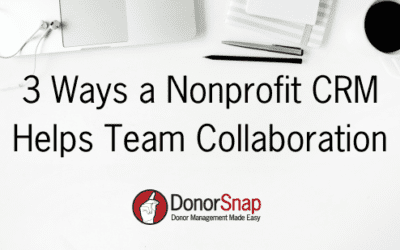Even if the busy holiday season seems far off, the more you prepare ahead of time, the more streamlined your year-end giving will be.
Below we cover what nonprofits should be doing before, during, and after the giving season to ensure success, improve processes, and streamline fundraising efforts.
To start, let’s look at the things you can do now, so you can focus on the immediate and unexpected things that inevitably come up during year-end fundraising.
How to Prepare Before Year-End Giving Season

1. Clean up your database
Before you start sending out mass mailings, make sure all of your records are up to date in your database. If you are using DonorSnap, contact us to set up your free annual NCOA cleaning. This service will run a check on all the contacts in your database and update their information if they have moved.
This is also a good time to reach out to donors who you haven’t heard from in a while. The best way to handle this is running an email campaign out of DonorSnap with a Responsive Form. Simply ask them to update their contact information in the form, and then those details will load into your database. Bonus: You can set this up as an automated campaign using our Automated Task Manager.
2. Tailor your mailing list for year-end giving
Once you have cleaned up your database you can start putting together your mailing lists. You will want both an email list and a direct mailing list. It is up to your organization how to build your list. For example, some organizations will contact everyone who has given in the last 3 years. Nonprofits should also consider segmenting their lists for more personalized communication.
You will also want to eliminate anyone from your mailing list who has already given. When you build your list in DonorSnap using Dataminer platinum, any changes in the database will automatically update your list. So if you have the list set to exclude anyone who already gave in this fiscal year, and someone gives before your mailing goes out, they will automatically be removed from the list.
For this reason, you can build your mailing lists ahead of time with the parameters you want, and have peace of mind that they will stay up to date as the giving season gets closer.
3. Craft your nonprofit’s year-end campaign message
Your nonprofit’s success during year-end giving depends on many factors. One of them is a powerful message. Depending on your organization you may have a consistent theme in your fundraising, or try something new each year.
However you craft your message, it is important to start thinking about it now. If you need some ideas to help you get started ask yourself the following questions:
- What happened in this year that was special or stood out?
- Did your organization reach any major milestones worth celebrating?
- Who do you serve and how do you make an impact?
- What is in it for your supporters?
- How did your supporters help drive impact?
Answering these questions can help you craft a thoughtful, donor-centric message that will drive action and engagement.
4. Develop and organize your year-end campaign content
Once you have your big picture message thought out, it is time to start building and organizing your content. Content includes blog posts, social posts, emails, infographics, videos, etc. Your content should support your message and tell a story over time. Your nonprofit should start developing and organizing your content now because building a content library and calendar is time-consuming. Also, a lack of planning could result in inconsistent and messy content. So getting your ducks in a row now will offer more seamless communication and save you time during the busy giving season.
5. Schedule your content
Now that you know what you want to share, it is time to plan when you will share it. It can be helpful to work backward from your year-end to decide how you will space things out. Some things to consider include what will your social media posting schedule look like? It is important to only commit to a manageable amount of posts. Consistency is very important for engagement, so even committing to 2 posts a week is better than posting 5 times one week and then not again for a month.
A content calendar is a great way to keep you organized. This should include social media content, emails blasts, appeal letters, direct mail, and necessary events or phone calls. You also might want to look into some social media management tools that will help you organize and schedule your content.
6. Make necessary updates
Before a busy giving season, you should comb through all of your communications to make sure everything is up to date. Run through your website and be sure there isn’t outdated information. Look through any automated emails you may have running and be sure everything is up to date and in line with this coming season’s messaging.
In addition, you should take a look at your online giving forms. Ensure the message on your forms is consistent with your year-end campaign. If you don’t already, you should consider adding a recurring giving option to your donation pages.
7. Brush up on your digital tools, or get new ones
The end of summer is a good time to analyze what software you have and see if there are any changes or updates you want to make. If you find you aren’t getting the most out of your tools, see if you and your team can do training. Taking time to learn your nonprofit’s software is a worthy investment for the time they will save you if used properly.
If you use DonorSnap, we offer two free one-on-one training sessions, so make sure you have used both of those. If you still think you need help we have an extensive help library with videos and help articles. In addition, we offer free weekly webinars on Wednesdays to cover different topics around using our database. Our exceptional support team is standing by to quickly answer any questions you have. In case that isn’t enough for your organization, we also offer additional paid trainings to cover any topics you’d like.
Tips for Success During Year-End Giving Season

The last month and a half of the year can be the busiest for non-profits. If you did your prep work prior to giving season, you should have saved yourself some time. However, that does not mean you don’t have a lot on your plate. Here are some of the ways you can make the most of your time during the year-end giving season.
1. Leverage GivingTuesday to your advantage
Although you may start your campaigns a bit before Thanksgiving, GivingTuesday tends to mark the true kick-off of the giving season. If you planned ahead, you should have a Giving Tuesday campaign to accompany your annual appeal mailings. GivingTuesday is primarily based around Social Media, but that does not mean you shouldn’t send out email marketing on Giving Tuesday as well.
Leading up to the day be sure to make plenty of posts highlighting your campaign. On the day of, send out an email blast with a link to your donate page. Encourage your supporters to get social as well by creating shareable content or encouraging them to create their own. Be sure to use the hashtag #givingtuesday on all of your social media content throughout your Giving Tuesday campaign. Learn more about setting up a successful GivingTuesday campaign here.
2. Hit send on your annual appeal
Whether you are doing a print mailing, an email, or a combination of both, it is time to send them out. If you are working with a print or mail house, you need to start organizing before Thanksgiving. Have your letter written and edited, remittance envelopes printed out, and all hands on deck if you are stuffing the envelopes yourself.
3. Engage with supporters
Even if you have your content on social media and email all scheduled out, your supporters are going to want to interact with you in real-time. So it is important to keep an eye on your social posts and respond to every comment you get on them. This will help with engagement and will show you are listening to your supporters.
4. Share your progress
As you move through the giving season, be sure to continuously thank all of your supporters, as well as share any updates on your fundraising progress. Setting a year-end goal can help build momentum and hype and may encourage second donations to help you reach a specific goal. Fundraising thermometer can be a fun addition to your digital communications during the giving season.
Tips for Success After Year-End Giving Season
1. Send your supporters a year-end campaign follow-up
Ideally, you should have thanked your donors individually as their donations came in. However, at the end of your year-end campaign you should put together a thoughtful follow-up. This message can be sent out as an email, through social media, and/or in your newsletter. Your year-end campaign follow-up should have four elements.
- Thank You: Thank everyone who gave and/or volunteered during your year-end fundraising.
- Results: Share how much was raised and if you met your fundraising goal or not.
- Impact: Explain how your year-end fundraising will make a difference for your organization and who/what you support.
- Next Steps: Keep the conversation going, although the giving season is over, now is the time to start building relationships and retain donors.
2. Take a look at your year-end giving analytics
Now that things are starting to slow down it is a great idea to analyze all of your data. There are a number of places you can analyze your year-end giving data. This includes Google Analytics for website data and Facebook Insights for social media data. Also, if you use DonorSnap you will have access to your email metrics as well as reports that will help you assess your fundraising data.
It is up to your organization to decide what you want to track. To get started, the best metrics to look at for each area are:
- Google Analytics – Start by looking at your overall website traffic. You can compare it over time to see if it has gone up or down. You can also set up goals to measure how many people left a donation after visiting your donation page. In addition, you can track your traffic sources to determine which pages on your website drew in the most visitors.
- Social Media Analytics – Reach and engagement are two of the most common social media metrics to look at. Reach is how many people saw your post and engagement is how many people interacted with the post. Look to see which types of posts got the most engagement and work to create more of those. Hint: The more you respond to comments on your posts, the better your engagement will be, so keep an eye on your social posts after they go out.
- Email Metrics – Open rate and click rate are important email metrics to measure. Your open rate can be affected by your subject line, time of day sent, or the frequency of your emails. So use this metric to see how you can improve these areas. Click rates are how many people were motivated to take further action after reading your email. Things that can affect click rate are what call to action you used, as well as the content within your email.
Analyzing your data will help you map out what was successful and what was not in your year-end giving campaigns.
3. Make notes of lessons learned
Tracking lessons learned is a common practice in project management, but nonprofits can benefit from this exercise too. It is essentially making note of everything that happened and what worked/didn’t. For example, say your print house took longer than expected and the mailing went out a week later than you wanted. Make a note to get the letters to the print house earlier next year. This sort of process documentation will help your nonprofit improve over time, and help them in the long term.
Summary
Year-end giving is one of the busiest times for nonprofits. There are a number of things your nonprofit can do to prepare for giving season, including:
- Cleaning up your database
- Tailor your mailing list
- Craft your year-end message
- Develop and organize your content
- Schedule your content
- Update your communications
- Brush up on your digital tools, or get new ones
If you take time to prepare for giving season, you can focus on the immediate tasks that come up during giving season. These include:
- Leveraging Giving Tuesday to Your Advantage
- Hit Send on your Annual Appeal
- Engage with Supporters
- Share Your Progress
Once giving season ends, you still have some important work to do. To tie up the giving season and lay the framework for a successful following year:
- Thank your Supporters
- Take a look at your Analytics
- Make Notes on Lessons Learned
Following these steps before, during, and after giving season will ensure you are on top of all your tasks every step of the way. Any way you can make good use of time is beneficial to nonprofits. There is always going to be the unexpected, so the more prepared you are ahead of time and the more you have planned out, the better your year-end giving will be.





